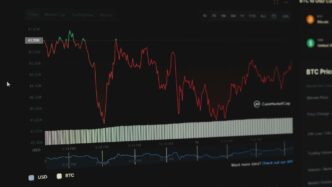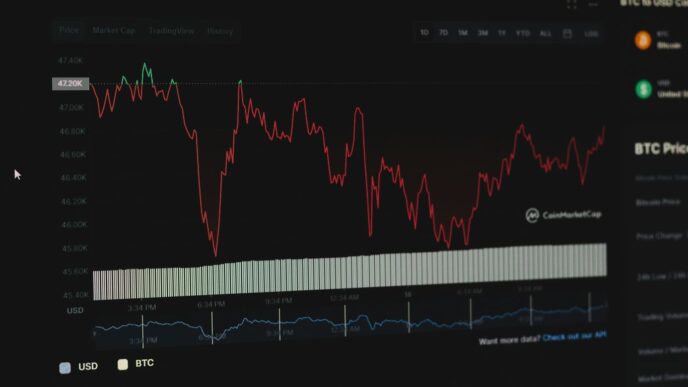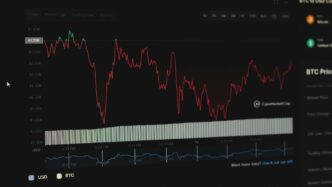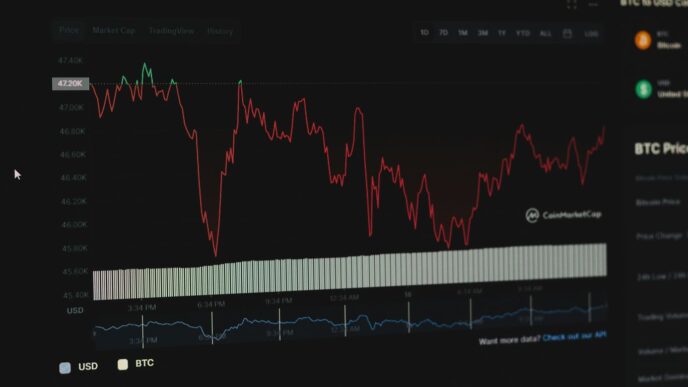So, you’ve been holding onto your crypto, watching it grow, and now you’re thinking about taxes. Specifically, the crypto long term capital gains tax. It sounds complicated, right? Well, it can be, but it doesn’t have to be a total headache. This guide is here to break down what you need to know for 2025. We’ll cover how holding periods affect your tax rate, how to actually figure out your gains, and some smart ways to manage it all. Let’s get this sorted so you can focus on your investments.
Key Takeaways
- Holding crypto for over a year means your profits are taxed at lower long-term capital gains rates, which are typically 0%, 15%, or 20%.
- Accurately tracking your cost basis (what you paid for your crypto) and acquisition dates is super important for calculating your taxable gains correctly.
- Events like selling crypto for cash, trading one crypto for another, or even using crypto to buy stuff are all considered taxable events.
- Strategies like holding assets for over a year and tax-loss harvesting can help reduce your overall crypto long term capital gains tax bill.
- Keeping good records of all your crypto transactions is vital, and don’t hesitate to get professional help from a tax expert if things get confusing.
Understanding Crypto Long Term Capital Gains Tax

So, you’ve been holding onto some crypto for a while, maybe even over a year. That’s great news when it comes to taxes! When you sell or trade crypto that you’ve held for more than one year, the profits you make are considered long-term capital gains. This is a big deal because these gains are taxed at a much lower rate than if you had sold them quickly. Think of it as a reward for being a patient investor.
What Constitutes Long-Term Crypto Gains?
Basically, to qualify for those sweet, lower long-term capital gains tax rates, you need to hold onto your cryptocurrency for over 365 days. The clock starts ticking the moment you acquire the crypto. So, if you bought Bitcoin on January 15th, 2024, and sell it on January 16th, 2025, or any date after that, you’re looking at long-term gains. It’s not just about selling; any transaction where you exchange your crypto for something else of value, like another coin or even goods and services, counts. The key is the holding period – more than a year is the magic number.
The Impact of Holding Duration on Your Tax Rate
This is where things get interesting and, frankly, much better for your wallet. Holding crypto for over a year significantly changes how your profits are taxed. Instead of being lumped in with your regular income, which can be taxed at rates as high as 37%, long-term capital gains are taxed at preferential rates. For 2025, these rates are generally 0%, 15%, or 20%, depending on your overall taxable income. The longer you hold, the more likely you are to fall into these lower brackets, saving you a considerable amount of money.
Here’s a quick look at the 2025 federal long-term capital gains tax rates:
| Tax Rate | Single Filer Income | Married Filing Jointly Income |
|---|---|---|
| 0% | $0 – $48,350 | $0 – $96,700 |
| 15% | $48,351 – $533,400 | $96,701 – $600,050 |
| 20% | $533,401+ | $600,051+ |
Note: These brackets are for federal taxes only and do not include potential state taxes or the Net Investment Income Tax.
Key Differences from Short-Term Crypto Gains
Short-term crypto gains are what you get when you sell or trade crypto held for one year or less. These are taxed at your ordinary income tax rate. So, if you’re in the 24% tax bracket, your short-term gains are taxed at 24%. This is a stark contrast to the 0%, 15%, or 20% rates for long-term gains. The IRS uses these different rates to encourage longer-term investing. It’s a pretty clear incentive: hold your assets longer, and you’ll likely pay less tax on your profits. This distinction is probably the most important thing to grasp when you’re thinking about your crypto taxes.
Calculating Your Crypto Long Term Capital Gains Tax Liability
Alright, so you’ve held onto some crypto for over a year, and now you’re looking at selling. That’s great for potentially lower tax rates, but first, we need to figure out exactly how much you owe. This part can get a little tricky, mostly because keeping track of everything is a pain. Unlike traditional stocks where your broker usually handles most of the heavy lifting, crypto is a bit more DIY.
Determining Your Cost Basis Accurately
This is probably the most important step, and honestly, where most people trip up. Your cost basis is basically what you paid for the crypto, including any fees. Think of it as your starting point. If you bought Bitcoin for $10,000 and later sold it for $20,000, your gain is $10,000. But if you bought it for $10,000 and sold it for $8,000, you have a loss of $2,000.
Here’s the catch: if you bought crypto at different times and at different prices, you need to know which crypto you’re selling. The IRS lets you choose a method for this:
- First-In, First-Out (FIFO): This is the default method if you don’t specify. You assume you’re selling the oldest crypto you bought first. So, if you bought 1 BTC at $5,000 and another at $10,000, and then sell 1 BTC, FIFO says you sold the $5,000 one.
- Specific Identification (Spec ID): This is where you get to pick exactly which crypto you’re selling. If you know you bought a specific coin at a high price and want to sell that one to minimize your gain (or maximize a loss), you can do that. You’ll need really good records for this.
- Last-In, First-Out (LIFO): This method assumes you sell the newest crypto first. It’s less common for crypto and not allowed for some assets, but it’s good to be aware of.
The Role of Acquisition Dates in Tax Calculations
This ties directly into your cost basis and whether your gains are short-term or long-term. Remember, for long-term capital gains, you need to have held the asset for more than one year. The exact date and time you acquired the crypto matters. If you bought Bitcoin on January 15, 2024, you can’t sell it on January 14, 2025, and call it long-term. You have to wait until January 16, 2025, to qualify for long-term treatment.
This is why keeping detailed records is so important. You need to know when you bought each chunk of crypto. If you’re using an exchange, they often provide this data, but you can’t always rely on it being perfect or easy to find.
Navigating Complex Transaction Histories
Most people don’t just buy one coin and hold it. You might have:
- Bought Bitcoin, then traded it for Ethereum.
- Bought Ethereum, then used it to buy NFTs.
- Received crypto from staking or mining.
- Bought crypto on multiple exchanges.
Each of these actions can be a taxable event. Trading one crypto for another, for example, is treated as selling the first crypto and buying the second. Using crypto to buy something is also a sale. This creates a tangled web of transactions that can be a nightmare to untangle manually. This is why using crypto tax software or hiring a professional is often the best bet for accuracy. They can help import your data from exchanges and wallets and sort through the mess to figure out your actual gains and losses.
2025 Tax Brackets for Crypto Long Term Capital Gains
So, you’ve held onto your crypto for over a year, which is fantastic news for your tax situation. This means your profits are now considered long-term capital gains, and they get taxed at a much friendlier rate than short-term gains. Instead of being lumped in with your regular income, these gains fall into special brackets. The IRS uses these brackets to determine if your long-term crypto profits will be taxed at 0%, 15%, or 20%.
Federal Long-Term Capital Gains Tax Rates
These rates are set based on your total taxable income for the year. It’s not just about how much you made from crypto; it’s your entire income picture. The IRS adjusts these income thresholds each year, so the 2025 numbers are what we’re looking at for gains realized in 2025 and reported in 2026. Holding assets for more than a year generally results in lower tax than short-term gains [7f28].
Impact of Filing Status on Your Tax Bracket
Your filing status makes a big difference in where you land within these brackets. Whether you file as Single, Married Filing Jointly, Married Filing Separately, or Head of Household, the income thresholds for each tax rate change. It’s important to know your status to figure out your exact tax rate.
Here’s a look at the estimated 2025 federal long-term capital gains tax brackets:
| Tax Rate | Single | Married Filing Jointly | Married Filing Separately | Head of Household |
|---|---|---|---|---|
| 0% | $0 – $48,350 | $0 – $96,700 | $0 – $48,350 | $0 – $64,750 |
| 15% | $48,351 – $533,400 | $96,701 – $600,050 | $48,351 – $300,000 | $64,751 – $566,700 |
| 20% | $533,401+ | $600,051+ | $300,001+ | $566,701+ |
Note: These figures are estimates for the 2025 tax year and are subject to change. Always refer to official IRS publications for the most current information.
Understanding the 0%, 15%, and 20% Brackets
- 0% Bracket: If your total taxable income falls within these lower ranges, you won’t owe any federal tax on your long-term crypto gains. This is a great incentive to hold assets for the long haul.
- 15% Bracket: Most people with long-term capital gains will likely fall into this middle bracket. It’s still a significantly lower rate than ordinary income tax.
- 20% Bracket: Higher earners will see their long-term crypto profits taxed at this rate. Even at 20%, it’s often more favorable than the top ordinary income tax rates.
Remember, these are just the federal rates. You might also owe state taxes depending on where you live, and high-income earners could be subject to the Net Investment Income Tax (NIIT) as well. Keeping good records is key, and if things get complicated, talking to a tax professional is always a smart move.
Taxable Crypto Events and Long-Term Holdings
So, you’ve been holding onto your crypto for over a year, which is great for those lower long-term capital gains tax rates. But what exactly counts as a taxable event when you’re dealing with digital assets? It’s not just about selling for dollars. The IRS considers several actions as triggering a tax liability, even if you’re staying within the crypto world.
Selling Crypto for Fiat Currency
This is the most straightforward one. When you cash out your crypto, converting it into traditional money like USD, EUR, or JPY, you’ve realized a gain or loss. If you bought Bitcoin for $10,000 and sell it for $20,000, that $10,000 profit is a capital gain. Since you held it for over a year, it falls under the long-term capital gains rules we’ve been discussing. This is a pretty common scenario, and it’s where most people start thinking about their crypto taxes.
Trading One Cryptocurrency for Another
This is where things can get a bit more complicated, but it’s still a taxable event. Let’s say you have Ethereum (ETH) and you decide to trade it for some Solana (SOL). The IRS views this as selling your ETH and then immediately buying SOL. You need to calculate the gain or loss on the ETH you traded away based on its cost basis and its fair market value at the time of the trade. So, if you bought ETH for $500 and traded it when it was worth $1,000, you have a $500 taxable gain, even though you didn’t get any cash. This is a key point to remember for anyone actively swapping between different digital assets. Understanding these exchanges is important for accurate reporting, especially if you’re looking at Canadian tax regulations [a4f3].
Using Crypto for Purchases
Think of using crypto like spending cash, but with a tax twist. If you buy a new gadget or pay for a service using Bitcoin, that’s also a taxable event. You have to figure out the fair market value of the crypto at the moment of purchase and compare it to your original cost basis. For example, if you bought Dogecoin for $100 and then used it to buy a $500 item, you have a $400 taxable gain. It doesn’t matter that you spent the crypto; the IRS sees it as disposing of an asset. This applies to everything from buying coffee to purchasing a car with crypto. It’s a good idea to keep records of these transactions, as they can add up quickly.
Here’s a quick rundown of common taxable events:
- Selling crypto for fiat currency: Converting your digital assets back into traditional money.
- Trading one cryptocurrency for another: Swapping one digital asset for a different one.
- Using crypto to purchase goods or services: Spending your crypto on everyday items or larger purchases.
Remember, holding your crypto for over a year generally qualifies any profits for the more favorable long-term capital gains tax rates. This is why many investors choose to hold their assets for extended periods, aiming to minimize their tax burden when they eventually decide to sell or trade.
Strategies to Optimize Your Crypto Long Term Capital Gains Tax
Okay, so you’ve held onto some crypto for over a year, and now you’re looking at those sweet long-term capital gains. That’s great! But how do you make sure you’re not handing over more than you have to in taxes? It’s not just about buying low and selling high; it’s also about being smart with your tax strategy. Let’s break down a few ways to keep more of your crypto profits.
The Benefit of Holding Assets Over One Year
This is probably the most straightforward way to cut down on your crypto taxes. If you hold onto a cryptocurrency for more than one year before selling it, any profit you make is considered a long-term capital gain. These gains are taxed at much lower rates than short-term gains, which are taxed as ordinary income. For 2025, these rates are generally 0%, 15%, or 20%, depending on your overall taxable income. Compare that to ordinary income rates, which can go up to 37%!
Here’s a quick look at the 2025 long-term capital gains tax rates:
| Tax Rate | Single Filer | Married Filing Jointly |
|---|---|---|
| 0% | Up to $55,800 | Up to $111,600 |
| 15% | $55,801 to $609,350 | $111,601 to $731,200 |
| 20% | Over $609,350 | Over $731,200 |
Note: These brackets are estimates for 2025 and may change. Always check the latest IRS guidelines.
So, if you’re thinking about selling, and you’ve held the asset for over a year, you’re already in a good spot. If you haven’t held it that long, and it’s not an emergency, waiting a bit longer could save you a significant amount. It’s a simple concept, but the impact on your tax bill can be huge.
Tax-Loss Harvesting for Crypto Investments
This strategy sounds a bit technical, but it’s really about using your losses to your advantage. Tax-loss harvesting involves selling investments that have decreased in value to realize a capital loss. You can then use these realized losses to offset capital gains you’ve made elsewhere. This applies to both short-term and long-term gains. If your losses exceed your gains, you can even deduct up to $3,000 of those excess losses against your ordinary income each year, and carry forward any remaining losses to future tax years. It’s a smart way to manage your overall tax liability. For example, if you sold some Bitcoin at a loss, you could use that loss to reduce the taxable gain from selling Ethereum. This is a common practice in traditional investing and works just the same for your crypto assets.
Optimizing Tax Lot Selection
This is where things can get a little more complicated, especially if you’ve bought the same cryptocurrency multiple times at different prices. When you sell a portion of your crypto, you have to decide which
Navigating Reporting Requirements for Crypto Long Term Capital Gains
Okay, so you’ve held onto your crypto for over a year, and now it’s time to figure out how to tell the IRS about it. This part can feel a bit like a maze, but it’s really about keeping good records and using the right forms. The IRS wants to know about your crypto gains, and they’re getting better at tracking them.
Essential Tax Forms for Crypto Transactions
When it comes to reporting your crypto activities, a few forms are usually involved. Think of them as the official paperwork for your digital asset adventures.
- Form 8949, Sales and Other Dispositions of Capital Assets: This is where you’ll list out all your crypto sales. You’ll detail the date you acquired the crypto, the date you sold it, your cost basis (what you paid for it), and the selling price. It sounds like a lot, but it’s just a way to itemize everything.
- Schedule D (Form 1040), Capital Gains and Losses: Once you’ve filled out Form 8949, you’ll summarize those numbers here. Schedule D is where your total capital gains and losses are calculated, and it feeds directly into your main Form 1040.
- Form 1040, U.S. Individual Income Tax Return: This is your main tax return. The net result from Schedule D will be reported on this form.
If your crypto activities were more like a business, you might also need to look at Schedule C (Form 1040), Profit or Loss From Business (Sole Proprietorship), and Schedule SE (Form 1040), Self-Employment Tax. But for most people just holding and selling, Form 8949 and Schedule D are the main players.
The Importance of Accurate Record-Keeping
Seriously, this is the big one. Without good records, figuring out your cost basis and holding periods becomes a headache. Imagine trying to remember exactly what you paid for that fraction of a Bitcoin you bought three years ago – not fun.
Here’s why keeping track is so important:
- Correctly Calculating Gains and Losses: You need to know what you paid for your crypto (your cost basis) to figure out your profit or loss when you sell. Holding for over a year means you’re aiming for those lower long-term capital gains rates, but you still need to prove that holding period.
- Avoiding IRS Penalties: If the IRS audits you and you can’t show proof of your transactions, you could face penalties and interest. They’re cracking down on crypto reporting, so being prepared is key.
- Peace of Mind: Honestly, just knowing you’ve got everything documented makes tax season a lot less stressful. You won’t be scrambling at the last minute trying to piece together information.
Most crypto exchanges provide a year-end statement that summarizes your transactions. While these are helpful, they might not always be perfect or capture every single transaction, especially if you use multiple platforms or a personal wallet. It’s a good idea to download your transaction history regularly and keep it in a safe place, maybe a dedicated folder on your computer or a cloud storage service.
When to Seek Professional Tax Assistance
Look, nobody expects you to be a tax expert, especially with something as complicated as crypto. If your crypto activity is extensive, involves complex transactions like DeFi or NFTs, or if you’re just feeling overwhelmed, getting help is a smart move.
A qualified tax professional who understands cryptocurrency can help you:
- Ensure you’re using the correct forms and reporting methods.
- Identify potential tax-saving opportunities you might have missed.
- Navigate specific situations, like receiving crypto as income or dealing with lost private keys.
- Double-check your calculations to prevent errors.
While tax software can be useful, it’s not a substitute for professional advice when things get complicated. Think of it as an investment in avoiding bigger headaches down the road. The IRS has been issuing more guidance on digital assets, and staying on top of it all can be a full-time job.
Wrapping It Up
So, we’ve gone over a lot of ground when it comes to crypto taxes for 2025. It’s definitely not as simple as just checking a box. Keeping good records is key, and knowing the difference between short-term and long-term gains can save you some serious cash. Remember those tax tables we looked at? They’re your friend. If all of this feels a bit overwhelming, that’s totally understandable. Lots of people find this stuff confusing. Don’t hesitate to get some professional help. It might just be worth it to make sure you’re doing things right and not missing out on ways to keep more of your hard-earned crypto.
Frequently Asked Questions
What exactly counts as a long-term crypto gain?
Think of it like this: if you hold onto your digital coins for more than a year before selling them for a profit, that profit is considered a long-term capital gain. It’s like planting a tree and waiting a long time to harvest the fruit – the reward is often greater, and in this case, the tax is usually lower.
How long do I need to hold crypto to get the lower tax rate?
To qualify for the special, lower tax rates on your crypto profits, you need to hold onto your digital assets for longer than one year. If you sell them within a year or less, those profits are taxed at a higher rate, similar to your regular income.
What’s the difference between short-term and long-term crypto gains?
The main difference is how long you owned the crypto before selling it for a profit. If you held it for a year or less, it’s a short-term gain, and the tax is usually higher. If you held it for more than a year, it’s a long-term gain, and the tax is typically lower.
How do I figure out my crypto’s ‘cost basis’?
Your cost basis is basically what you originally paid for your crypto, including any fees. It’s super important because you subtract this from the selling price to find out your profit. Keeping good records of when you bought and how much you paid for each bit of crypto is key to getting this right.
Do I have to pay taxes if I trade one crypto for another?
Yes, unfortunately. When you trade one type of cryptocurrency for another, like swapping Bitcoin for Ethereum, the IRS sees that as selling the first one. You’ll need to figure out if you made a profit or a loss on that trade and report it.
What are the actual tax rates for long-term crypto gains in 2025?
For 2025, the tax rates on profits from crypto held over a year can be 0%, 15%, or 20%. Which rate applies to you depends on your total income for the year and your filing status (like single or married). Generally, the more you earn, the higher the rate, but it’s still much lower than taxes on short-term gains.














